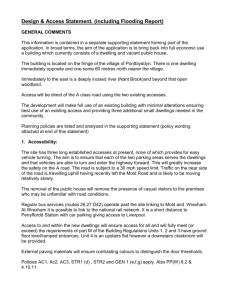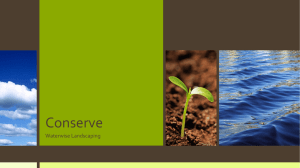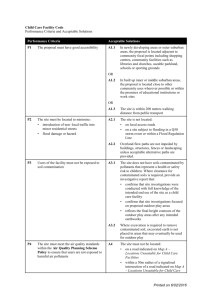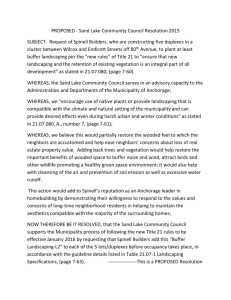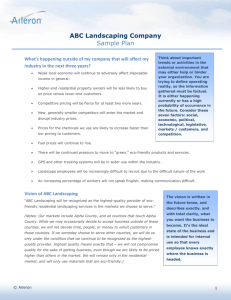industrial areas
advertisement
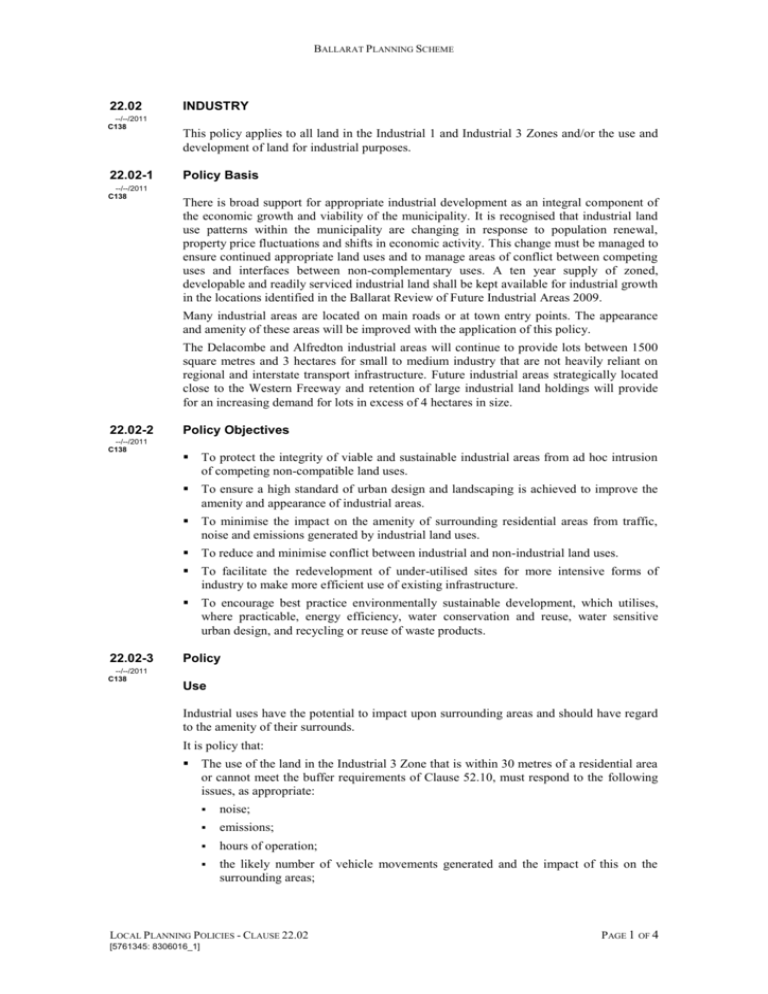
BALLARAT PLANNING SCHEME 22.02 --/--/2011 C138 --/--/2011 C138 --/--/2011 C138 22.02-1 --/--/2011 C138 INDUSTRY This policy applies to all land in the Industrial 1 and Industrial 3 Zones and/or the use and development of land for industrial purposes. Policy Basis There is broad support for appropriate industrial development as an integral component of the economic growth and viability of the municipality. It is recognised that industrial land use patterns within the municipality are changing in response to population renewal, property price fluctuations and shifts in economic activity. This change must be managed to ensure continued appropriate land uses and to manage areas of conflict between competing uses and interfaces between non-complementary uses. A ten year supply of zoned, developable and readily serviced industrial land shall be kept available for industrial growth in the locations identified in the Ballarat Review of Future Industrial Areas 2009. Many industrial areas are located on main roads or at town entry points. The appearance and amenity of these areas will be improved with the application of this policy. The Delacombe and Alfredton industrial areas will continue to provide lots between 1500 square metres and 3 hectares for small to medium industry that are not heavily reliant on regional and interstate transport infrastructure. Future industrial areas strategically located close to the Western Freeway and retention of large industrial land holdings will provide for an increasing demand for lots in excess of 4 hectares in size. 22.02-2 --/--/2011 C138 Policy Objectives To protect the integrity of viable and sustainable industrial areas from ad hoc intrusion of competing non-compatible land uses. To ensure a high standard of urban design and landscaping is achieved to improve the amenity and appearance of industrial areas. To minimise the impact on the amenity of surrounding residential areas from traffic, noise and emissions generated by industrial land uses. To reduce and minimise conflict between industrial and non-industrial land uses. To facilitate the redevelopment of under-utilised sites for more intensive forms of industry to make more efficient use of existing infrastructure. To encourage best practice environmentally sustainable development, which utilises, where practicable, energy efficiency, water conservation and reuse, water sensitive urban design, and recycling or reuse of waste products. 22.02-3 --/--/2011 C138 Policy Use Industrial uses have the potential to impact upon surrounding areas and should have regard to the amenity of their surrounds. It is policy that: The use of the land in the Industrial 3 Zone that is within 30 metres of a residential area or cannot meet the buffer requirements of Clause 52.10, must respond to the following issues, as appropriate: noise; emissions; hours of operation; the likely number of vehicle movements generated and the impact of this on the surrounding areas; LOCAL P LANNING POLICIES - CLAUSE 22.02 [5761345: 8306016_1] PAGE 1 OF 4 BALLARAT PLANNING SCHEME The off-site impacts of any use on surrounding areas, particularly residential areas and more sensitive land uses. Industrial uses will be discouraged from locating in Mixed Use Zones where there is a potential for conflict with other uses. These uses should be located in industrial zones. Buffer Requirements The development of Ballarat has resulted in many industrial areas that are encumbered by surrounding sensitive uses. It is policy that: Old and inappropriate industrial areas will be assisted in the transition to more appropriate land uses. New industry that requires significant buffers will be accommodated in areas where there are relatively few operational constraints. Existing industry that complies with operating requirements will be supported by Council. Environmental Impact and Sustainability Industry can improve its sustainability and minimise its environmental footprint by reducing resource consumption and greenhouse gas emissions. It is policy that: Industries shall be encouraged to adopt best practice principles to minimise adverse off site environmental impacts, including the use of the quietest, lowest emission and technologically advanced equipment. Encourage industrial activities that utilise environmentally sustainable and energy efficient practices, water conservation and reuse, water sensitive urban design, and recycling or reuse of waste products. Subdivision Subdivision patterns have a direct impact on the form of urban development, urban design outcomes and the streetscape. It is policy that: Lots are of a sufficient size so as to accommodate all intended needs on-site including parking (truck, car, bicycle and disabled), storage, loading/unloading and landscaping. Subdivision of industrial land will be discouraged, unless in accordance with an approved development plan, to facilitate better design solutions and meet the lot size requirements in specific locations. Land with frontages to highways and major roads, or abutting freeways, should be subdivided into large lots to allow for high amenity development which incorporates landscaping, appropriate setbacks and sensitive building design and siting. The layout, use and intensity of buildings and provision for car parking be established prior to the subdivision and development of existing buildings. Lot Size A range of lot sizes will be provided to meet the needs of small, medium and large industrial activities. It is policy that: A range of lot sizes, 1500 square metres to 3 hectares, will be provided in the Delacombe and Alfredton industrial areas to accommodate small to medium sized industrial needs. Large lots, 4 hectares or greater in area, will be provided in future industrial LOCAL P LANNING POLICIES - CLAUSE 22.02 [5761345: 8306016_1] PAGE 2 OF 4 BALLARAT PLANNING SCHEME investigation areas to service medium to large industry that require excellent access to the Western Freeway. Consolidation of holdings to promote larger scale development where appropriate will be encouraged. Transport/Access Appropriate location of industrial development will minimise impacts on residential areas. Well-designed access ways and loading bays will reduce traffic conflicts and improve traffic flows within the site and neighbouring sites. It is policy that: The design and layout of industrial developments should enable trucks to enter and exit the site in a forward direction. Sufficient parking should be provided on-site for staff and visitors, trucks, cars, bicycles and disabled persons. Traffic flow to and from industrial areas is to be improved, where possible, to minimise the impact of noise and congestion on any surrounding residential areas. Industries that rely heavily on road infrastructure, such as, transport and storage businesses, should be encouraged to locate on sites with good access to major arterial roads. Site Layout and Facilities A high standard of urban design and amenity is desired within industrial areas to create a strong sense of place and to provide a quality environment for workers and visitors. Fencing on the front boundary of properties and in front of buildings can detract from the open streetscape appearance of industrial areas and limit the ability to provide attractive landscaped frontages that soften the visual impact of developments. It is policy that: Industrial development in the immediate vicinity of residential uses, open space or other sensitive land uses should enhance the preferred urban character of the neighbourhood, particularly in regard to the scale of the building, its landscaping, its setback from the street frontage and any abutting non-industrial uses. Any proposal to use or develop land for industrial purposes in the immediate area of residential uses, open space or other sensitive land uses must incorporate measures to limit adverse impact on the surrounding area, in particular, the emission of noise, artificial light, vibration, odour, fumes, smoke, vapour, steam, soot, ash, dust, waste water, waste products, grit or oil. Industrial and commercial development adjacent to arterial roads and rail corridors should address those interfaces and be of a high visual standard to enhance the amenity of the transport corridors. Plant and equipment, including air conditioning units, must be insulated and located to minimise noise impacts on the surrounding area. New buildings should be of contemporary design, address the streetscape, incorporate elements that add visual interest, and make use of modern materials. The use of front setbacks should be restricted to landscaping, visitor car parking, access ways and signage. Storage and waste areas are to be appropriately secured and screened from sensitive uses and public sight. Existing industries should be encouraged to take appropriate measures to improve their site when proposing expansion or redevelopment, including: reducing/minimising nuisance; improving maintenance of buildings and grounds; LOCAL P LANNING POLICIES - CLAUSE 22.02 [5761345: 8306016_1] PAGE 3 OF 4 BALLARAT PLANNING SCHEME surfacing of parking areas, access ways; providing landscaping and improved maintenance of grounds; and providing screened areas for storage, including storage of wastes Fencing should be located at or behind the building line and is discouraged along the front boundary or in front of the building line. If security fencing is required, it should be recessed behind the building line. If front fencing is required, it should be low level and colour coated (not exposed wire or uncoated timber). Landscaping Landscape treatment should enhance the visual appearance of development and be used to create an attractive and sustainable environment. Where practical landscaping should improve the amenity of surrounding area. It is policy that: Landscaping should be provided within front and side setbacks to the street, to car parking areas and around outdoor goods storage areas. Landscaping should also be provided along rear and side boundaries, particularly those, which form an interface with sensitive uses such as, residential or public open space areas or are visually prominent. Landscaping plans must be submitted with permit applications and should provide for: the retention of existing vegetation, where practicable. simple, low maintenance landscaping which complements existing landscaping themes; the use of low water use plants and indigenous plants and the avoidance of use of environmental weeds; the provision of canopy trees; provision of trees in car parking areas; and landscaping of access ways. Where ten or more car parking spaces are provided, trees or other appropriate landscaping treatments, are required to increase permeability, provide shade and improve the visual amenity of the area. Signage Signage must be integrated into the development. It is policy that: The number of advertising signs be minimised and, where possible, incorporated in the design of the building to avoid visual clutter. Where multiple businesses operate on a site, a single shared advertising hoarding is encouraged. LOCAL P LANNING POLICIES - CLAUSE 22.02 [5761345: 8306016_1] PAGE 4 OF 4

